Abstract
OBJECTIVES: A population-based case-control study was conducted in central North Carolina to assess the relationship between occupational stress and preterm delivery. METHODS: Four hundred twenty-one women delivering infants before 37 weeks' gestation and 612 women delivering infants at term were interviewed a median of 6 months after delivery. Exposure information was collected for all jobs held for at least 1 month during pregnancy. RESULTS: Work in a "high strain" job (i.e., high demand and low control) was not associated with increased risk of preterm delivery compared with work in "low strain" jobs (all other combinations of job demand and control). Narrowing the exposure window to the third trimester did not modify the results. However, women who worked at a high-strain job full-time (odds ratio [OR] = 1.4, 95% confidence interval [CI] = 0.9, 2.0) or for 30 or more weeks (OR = 1.4, CI = 1.0, 2.2) had a modestly increased risk. Several analyses suggested that Black women were at greater risk from job strain than White women. CONCLUSIONS: This study suggests that chronic exposure during pregnancy to work characterized by high demand and low control may be modestly associated with preterm delivery.
Full text
PDF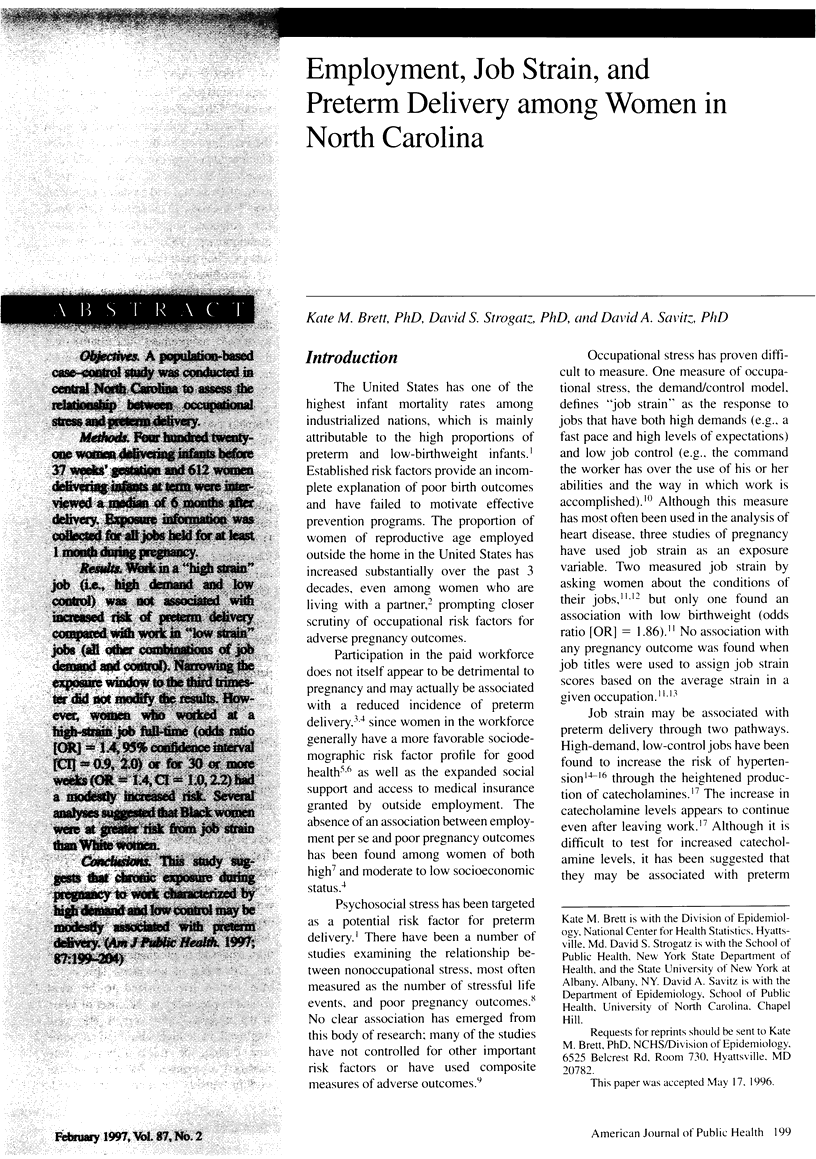
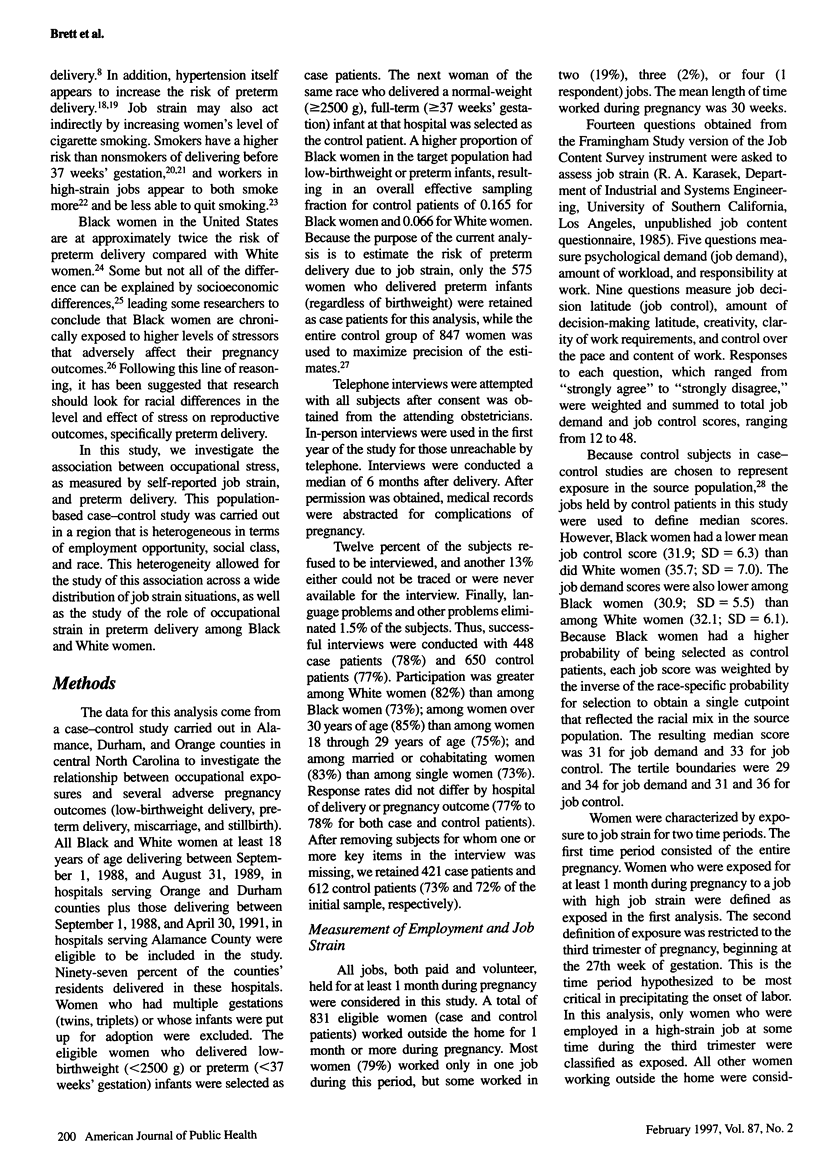
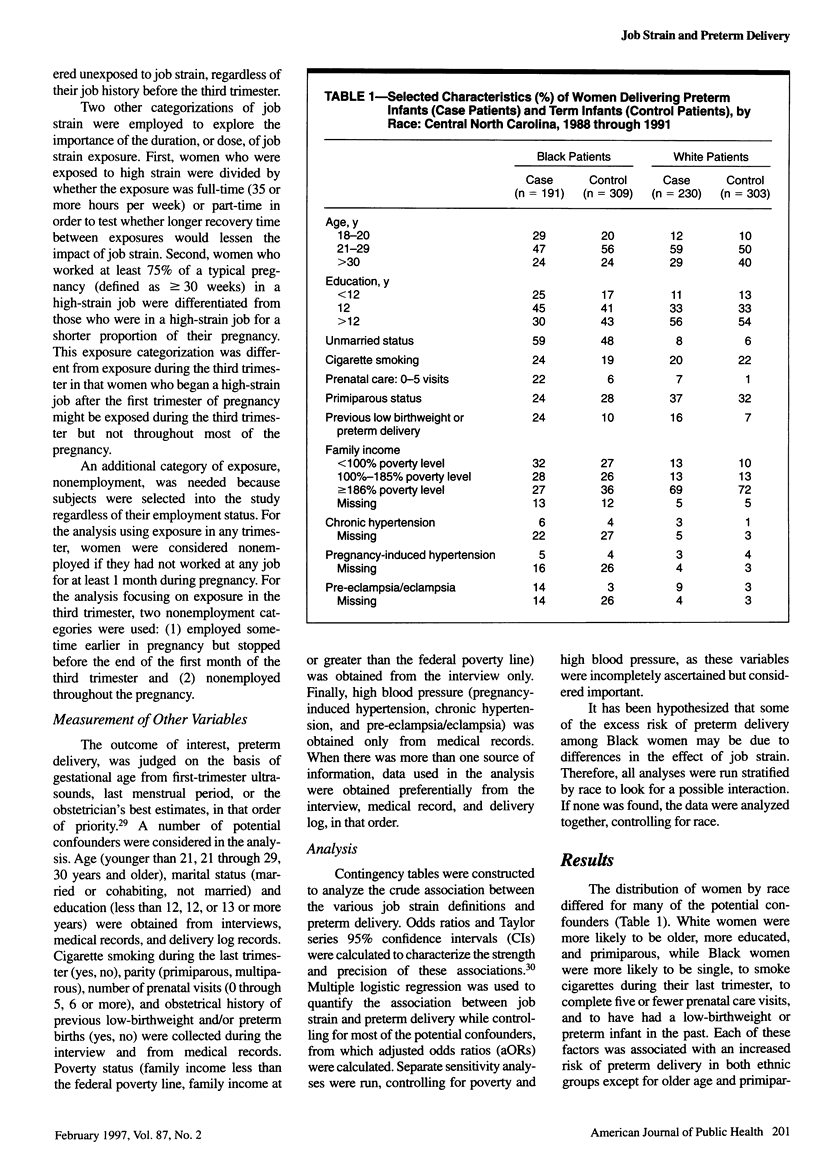
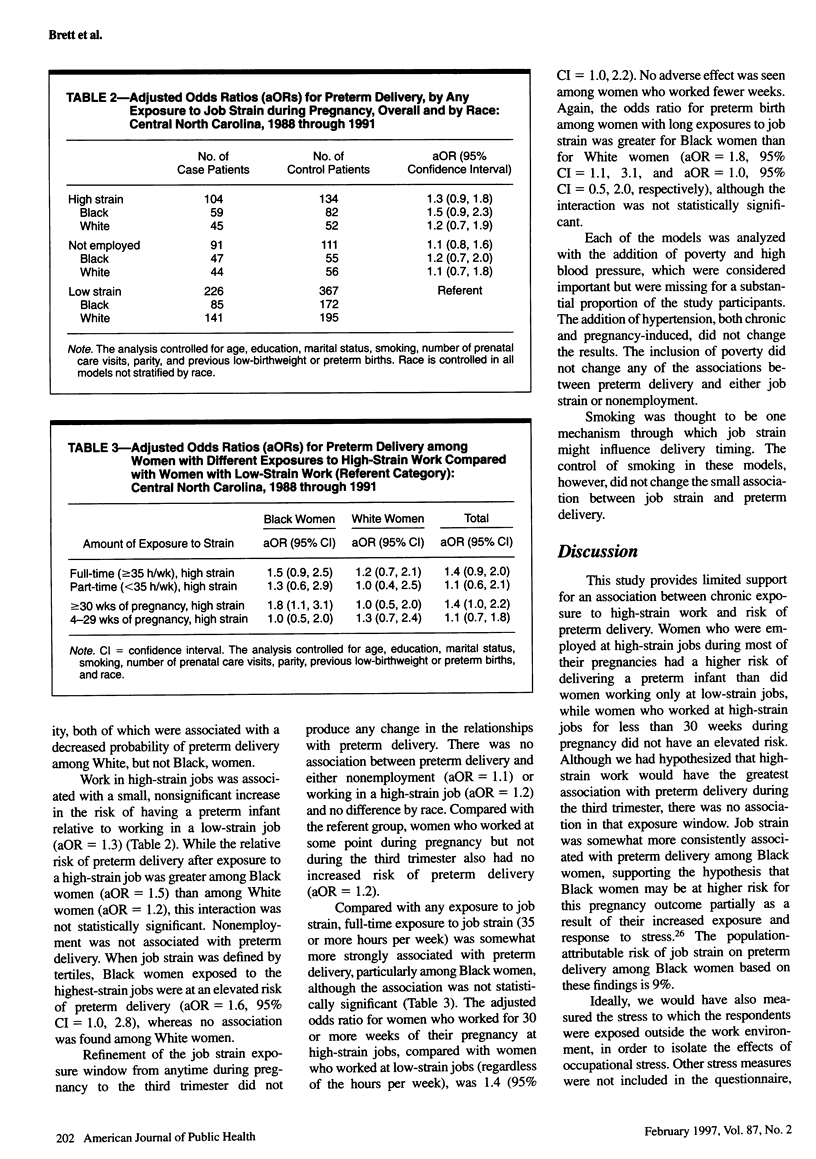
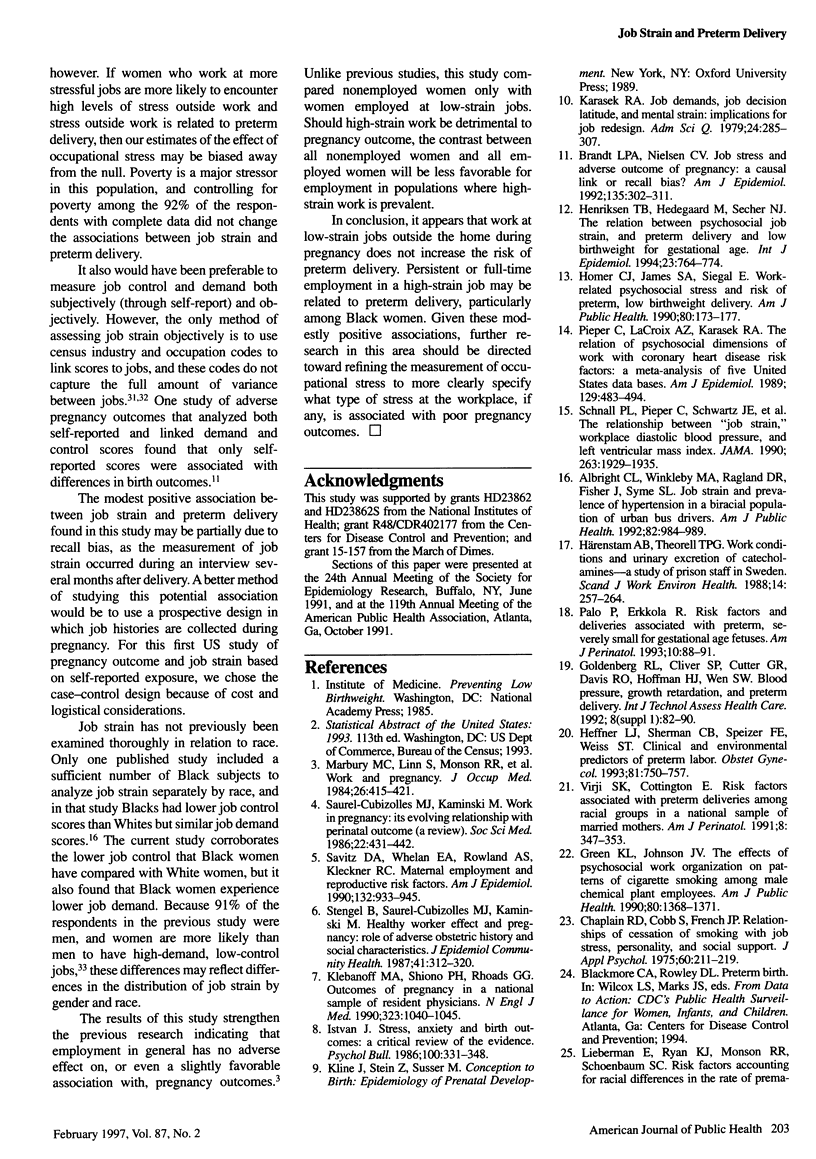
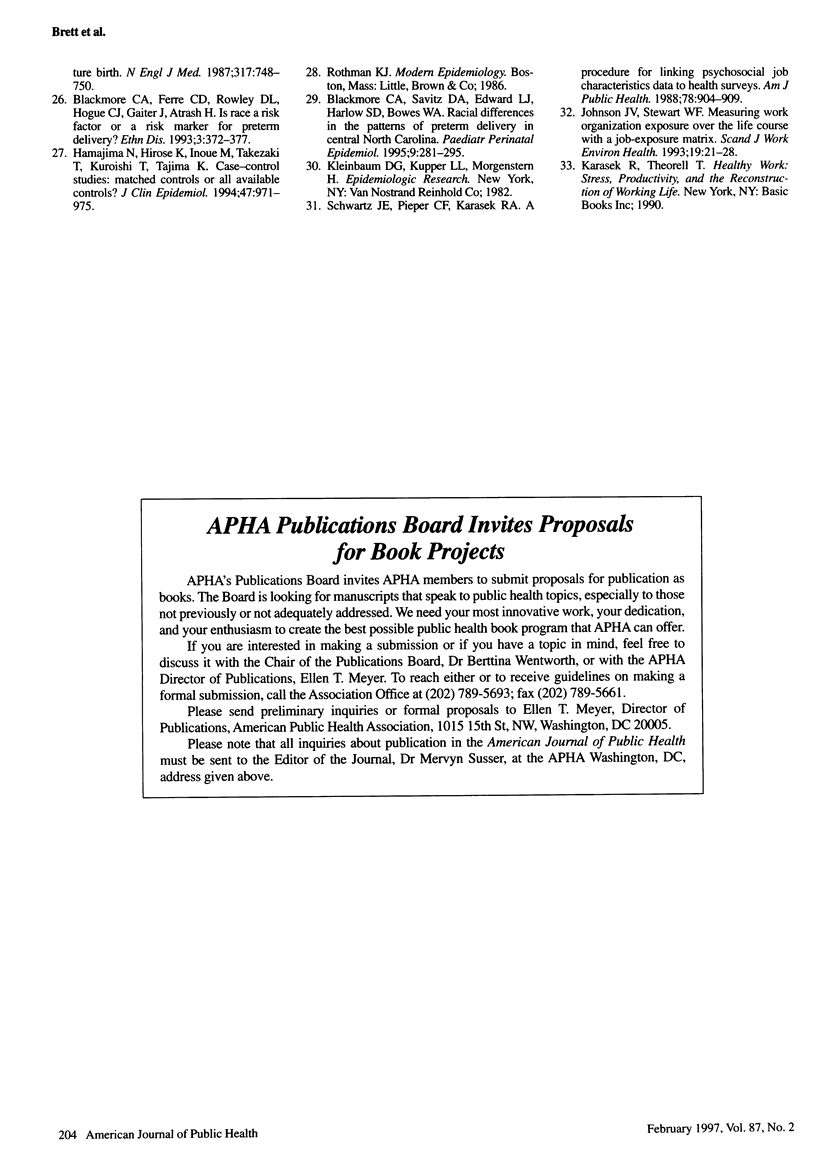
Selected References
These references are in PubMed. This may not be the complete list of references from this article.
- Albright C. L., Winkleby M. A., Ragland D. R., Fisher J., Syme S. L. Job strain and prevalence of hypertension in a biracial population of urban bus drivers. Am J Public Health. 1992 Jul;82(7):984–989. doi: 10.2105/ajph.82.7.984. [DOI] [PMC free article] [PubMed] [Google Scholar]
- Blackmore C. A., Ferré C. D., Rowley D. L., Hogue C. J., Gaiter J., Atrash H. Is race a risk factor or a risk marker for preterm delivery? Ethn Dis. 1993 Fall;3(4):372–377. [PubMed] [Google Scholar]
- Blackmore C. A., Savitz D. A., Edwards L. J., Harlow S. D., Bowes W. A., Jr Racial differences in the patterns of preterm delivery in central North Carolina, USA. Paediatr Perinat Epidemiol. 1995 Jul;9(3):281–295. doi: 10.1111/j.1365-3016.1995.tb00144.x. [DOI] [PubMed] [Google Scholar]
- Brandt L. P., Nielsen C. V. Job stress and adverse outcome of pregnancy: a causal link or recall bias? Am J Epidemiol. 1992 Feb 1;135(3):302–311. doi: 10.1093/oxfordjournals.aje.a116284. [DOI] [PubMed] [Google Scholar]
- Caplan R. D., Cobb S., French J. R., Jr Relationships of cessation of smoking with job stress, personality, and social support. J Appl Psychol. 1975 Apr;60(2):211–219. doi: 10.1037/h0076471. [DOI] [PubMed] [Google Scholar]
- Goldenberg R. L., Cliver S. P., Cutter G. R., Davis R. O., Hoffman H. J., Wen S. W. Blood pressure, growth retardation, and preterm delivery. Int J Technol Assess Health Care. 1992;8 (Suppl 1):82–90. doi: 10.1017/s0266462300012952. [DOI] [PubMed] [Google Scholar]
- Green K. L., Johnson J. V. The effects of psychosocial work organization on patterns of cigarette smoking among male chemical plant employees. Am J Public Health. 1990 Nov;80(11):1368–1371. doi: 10.2105/ajph.80.11.1368. [DOI] [PMC free article] [PubMed] [Google Scholar]
- Hamajima N., Hirose K., Inoue M., Takezaki T., Kuroishi T., Tajima K. Case-control studies: matched controls or all available controls? J Clin Epidemiol. 1994 Sep;47(9):971–975. doi: 10.1016/0895-4356(94)90111-2. [DOI] [PubMed] [Google Scholar]
- Heffner L. J., Sherman C. B., Speizer F. E., Weiss S. T. Clinical and environmental predictors of preterm labor. Obstet Gynecol. 1993 May;81(5 ):750–757. [PubMed] [Google Scholar]
- Henriksen T. B., Hedegaard M., Secher N. J. The relation between psychosocial job strain, and preterm delivery and low birthweight for gestational age. Int J Epidemiol. 1994 Aug;23(4):764–774. doi: 10.1093/ije/23.4.764. [DOI] [PubMed] [Google Scholar]
- Homer C. J., James S. A., Siegel E. Work-related psychosocial stress and risk of preterm, low birthweight delivery. Am J Public Health. 1990 Feb;80(2):173–177. doi: 10.2105/ajph.80.2.173. [DOI] [PMC free article] [PubMed] [Google Scholar]
- Härenstam A. B., Theorell T. P. Work conditions and urinary excretion of catecholamines--a study of prison staff in Sweden. Scand J Work Environ Health. 1988 Aug;14(4):257–264. doi: 10.5271/sjweh.1923. [DOI] [PubMed] [Google Scholar]
- Istvan J. Stress, anxiety, and birth outcomes: a critical review of the evidence. Psychol Bull. 1986 Nov;100(3):331–348. [PubMed] [Google Scholar]
- Johnson J. V., Stewart W. F. Measuring work organization exposure over the life course with a job-exposure matrix. Scand J Work Environ Health. 1993 Feb;19(1):21–28. doi: 10.5271/sjweh.1508. [DOI] [PubMed] [Google Scholar]
- Klebanoff M. A., Shiono P. H., Rhoads G. G. Outcomes of pregnancy in a national sample of resident physicians. N Engl J Med. 1990 Oct 11;323(15):1040–1045. doi: 10.1056/NEJM199010113231506. [DOI] [PubMed] [Google Scholar]
- Marbury M. C., Linn S., Monson R. R., Wegman D. H., Schoenbaum S. C., Stubblefield P. G., Ryan K. J. Work and pregnancy. J Occup Med. 1984 Jun;26(6):415–421. doi: 10.1097/00043764-198406000-00013. [DOI] [PubMed] [Google Scholar]
- Palo P., Erkkola R. Risk factors and deliveries associated with preterm, severely small for gestational age fetuses. Am J Perinatol. 1993 Jan;10(1):88–91. doi: 10.1055/s-2007-994712. [DOI] [PubMed] [Google Scholar]
- Pieper C., LaCroix A. Z., Karasek R. A. The relation of psychosocial dimensions of work with coronary heart disease risk factors: a meta-analysis of five United States data bases. Am J Epidemiol. 1989 Mar;129(3):483–494. doi: 10.1093/oxfordjournals.aje.a115159. [DOI] [PubMed] [Google Scholar]
- Saurel-Cubizolles M. J., Kaminski M. Work in pregnancy: its evolving relationship with perinatal outcome (a review). Soc Sci Med. 1986;22(4):431–442. doi: 10.1016/0277-9536(86)90048-1. [DOI] [PubMed] [Google Scholar]
- Savitz D. A., Whelan E. A., Rowland A. S., Kleckner R. C. Maternal employment and reproductive risk factors. Am J Epidemiol. 1990 Nov;132(5):933–945. doi: 10.1093/oxfordjournals.aje.a115736. [DOI] [PubMed] [Google Scholar]
- Schnall P. L., Pieper C., Schwartz J. E., Karasek R. A., Schlussel Y., Devereux R. B., Ganau A., Alderman M., Warren K., Pickering T. G. The relationship between 'job strain,' workplace diastolic blood pressure, and left ventricular mass index. Results of a case-control study. JAMA. 1990 Apr 11;263(14):1929–1935. [PubMed] [Google Scholar]
- Schwartz J. E., Pieper C. F., Karasek R. A. A procedure for linking psychosocial job characteristics data to health surveys. Am J Public Health. 1988 Aug;78(8):904–909. doi: 10.2105/ajph.78.8.904. [DOI] [PMC free article] [PubMed] [Google Scholar]
- Stengel B., Saurel-Cubizolles M. J., Kaminski M. Healthy worker effect and pregnancy: role of adverse obstetric history and social characteristics. J Epidemiol Community Health. 1987 Dec;41(4):312–320. doi: 10.1136/jech.41.4.312. [DOI] [PMC free article] [PubMed] [Google Scholar]
- Virji S. K., Cottington E. Risk factors associated with preterm deliveries among racial groups in a national sample of married mothers. Am J Perinatol. 1991 Sep;8(5):347–353. doi: 10.1055/s-2007-999412. [DOI] [PubMed] [Google Scholar]


